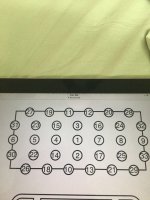Ok Randy, here you go. These old engines used the USA standard SAE bolts & threads in a Coarse Thread (today is called UNC) or A Fine Thread (UNF). Once you ID the bolt size diameter, it's thread pitch, and the bolts Grade (if you need help with this post a picture of a bolt showing the head details. After you know the bolts specs you should be able to find a replacement head bolt or a suitable bolt to use in its place and be able to modify a standard bolt to work. Places to look for these type bolts try at any old time locale car and truck mechanic shops usally they have lots of spare bolts, some of bigger auto parts stores (maybe some of the NAPA stores like at one their main warehouses), larger hardware store (maybe at Granger) or the many large fastener companies probally at Fastenal.
https://www.fastenal.com/
The standard hardware bolts that can you find maybe a little bit longer than your original bolt but you can shorten them easyly by installing a standard nut on the new bolt to use as a guide cutting off the end to length with a hack saw or a thin cut off wheel. Than turn that guide nut up higher on the bolt and use a grinder to dress the end of the bolt with a small radius before you remove the nut, the nut will also chase the threads cleaning them out as you remove it. If you have a standard Tap and Die set you could also use the correct size Die to go over the thread again to clean them up a little more. When rebuilding engines I also like to use the corect size Tap in all the short blocks threads (open holes) or a bottoming tap (in blind holes) to chase out the threads removing all the dirt and rust etc. so you can get a good torque reading during reassembly.
Here are the 254 M Flathead Six Head Bolt Torque Specs note the correct bolt tightening pattern is in the below attachment.
On a 1948 254 M Engine its 50 to 60 FT. LB's.
For a 1949 to 1953 254 M Engine its 65 to 75 FT. LB's.
From my training as a A & P Mechanic I got in the habit of always using a three step bolt torque / tightening process. As example for the 1948 engine I would start at 20 Ft. Lb's going through the below attachment of the recommended Ford bolt torque pattern (see it in below attachment). Next I would go to 40 Ft. Lb's. And finishing up at 55 Ft. Lb's. For the 1949'to 1953 254 M I would use 25 ft lb, 50 ft lb., and then 70 ft. lb. One final note with the use of the common older style Head gaskets, it is recommended that the engine should be run and warmed up good next the head bolts are retorqued to the finish torque spec. I would also repeat this step again after the engine was in service for awhile though that's probally not nessisary many of the older mechanics I learned from used that practice. If your using one the newer style head gaskets such as a FelPro Perma Torque then this re torque isn't needed. Below is also all the bolt torques for the the 1949 to 1953 Ford H 226 six’s they should be the same for all other bolt on type parts like a water pump, manifolds, etc. used on the 254 M.
If all else fails when your having trouble finding bolt torques for some of these less known antique engines and other equipment you can also use one of the standard bolt torque charts for the bolt size, thread, and grade (see below) which should be close to what would of been used. Hope that helps get your 254 M up and running again best of luck.
Standard Bolt Torque Chart
1949 to 1951 Ford 226 H Series Flathead Six Bolt Torques

www.vanpeltsales.com

